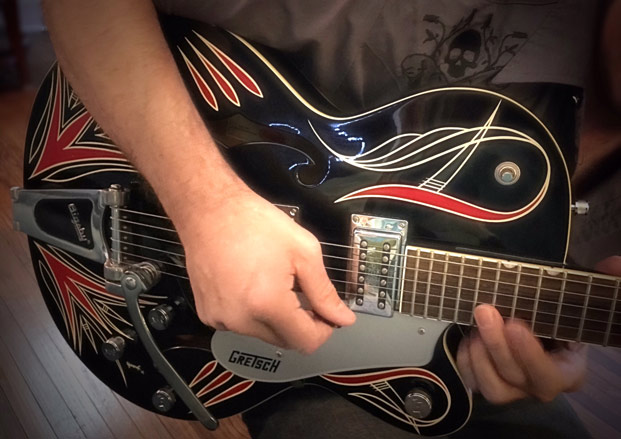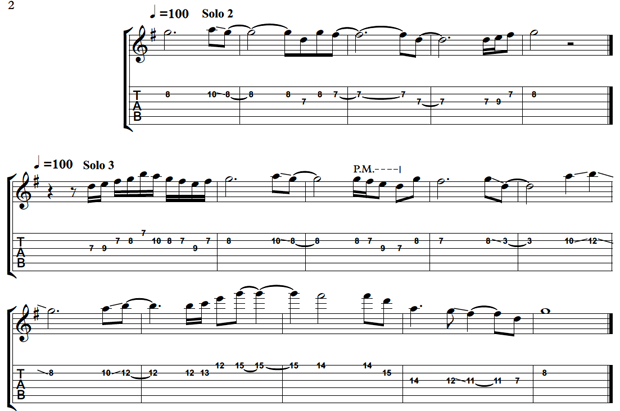An Introduction to Effective Use of Melody
Learn how to effectively incorporate melody into a solo.

For many guitarists learning to play solos, it can be easy to fall into a rut—based on a certain hand position of a scale—and, in doing so, forget to play melodically.
In this lesson, we will focus on learning to effectively incorporate melody into a solo. After all, iconic melodies are what set great guitar solos apart in many instances.
For this example, we will work with a chord progression moving from G major to E minor to D major, and we will solo in the G major scale.
And in this exercise, we will focus on a single string to help avoid getting stuck in a rut of simply playing from string to string across a familiar particular position of the major scale.
Although we will use the second string, or B string, you really could replicate this exercise with any of the strings. So, as a first step, let’s think about the G major scale in terms of only the second string.

Then let’s think about where these three chords in our progression (G major, E minor and D major) fall on the fretboard, so we can chase these chords around on the neck, so to speak. (A quick note on this point: One system many players use to learn to locate chords all over the neck is the CAGED system, and a simple Google search for “CAGED system” will bring up a host of websites explaining this relatively straightforward method for learning scale positions on the fretboard.)
For example, there is a standard G barre chord at the third fret, the G chord falls at the seventh and eighth frets on the first through third strings using your open D major triad shape, and there is fifth-string G barre chord at the 10th fret. What we will try to do is visualize these G chords all over the fretboard along with the notes in the G scale falling on the second string, so that we can use them when the G chord is playing in the progression.
All the latest guitar news, interviews, lessons, reviews, deals and more, direct to your inbox!

Considering playing the G major scale on the second string, the note at the third fret (within the barre chord is a D), there is a G at the eighth fret (within the open D major triad shape), and there is a B at the 12th fret (within the fifth-string G major barre chord). Don’t worry or feel intimidated if you don’t understand a ton of music theory at this point, which you can learn more about separately. These are just examples, and you see how they can be used in this exercise.

Our goal here is to plot points on the fretboard corresponding to notes we can emphasize when the G major chord plays in the progression. And, likewise, we can plot similar points for the E minor and D major chords to have options for what to emphasize when these chords are played:
• Considering the second string and the E minor chord: There is an open B (within the open E minor chord), and there is a G at the eighth fret (within the fifth-string E minor barre chord).
• Considering the second string and the D major chord: There is a D at the third fret (within the open D major chord), and there is a G at the eighth fret (within the fifth-string D major barre chord).
As you will see, you can use these notes to play a solo within the chord progression, developing a melody. Obviously, at this point, we are not trying to play the fastest or flashiest solo incorporating the most notes possible. We just want to play something simple and focus on developing a melody that moves the song forward coherently.

As you’ll notice in this example solo, we start with the G on the eighth fret of the second string, playing it over the G major chord and again over the E minor chord, because the note G is found in both of those chords. From there, we move down to the F# at the seventh fret of the second string over the D chord, as F# is a note found in that chord.
I use a D at the third fret of the second string over the D major chord. The second pass begins again with the G on the eighth fret of the second string over the G major chord, walks up to the B at the 12th fret of the second string over the E minor chord, and then walks down to the F# at the seventh fret of the second string. The A notes in the solo, played at the tenth fret of the second string between notes, are used to keep the solo moving and provide additional color.
Once again, although this particular solo is not the most exciting thing you will ever play, this exercise is worth pursuing to help develop a focus on melody, because most memorable guitar solos incorporate strong melodic components to get beyond merely being an incoherent jumble of guitar acrobatics.
From there, of course, you can continue to build additional notes onto the solo, and your ability to add additional notes, color, and motion to your melodies will only increase as you grow in your knowledge and understanding of the guitar fretboard and other more general aspects of music like music theory and ear training.

- Ultimately, you’ll find that the more you know about the fretboard, the more you can visualize the scales and the chord shapes; and you can use this knowledge to think in visual terms about your options of what to play in connection the different chord progressions you want to solo over.
Doing this will help you develop a broader understanding of the notes that will sound natural and melodic, giving you the building blocks you need to create melodies of your own.
Steve Stine is a longtime and sought-after guitar teacher who is professor of Modern Guitar Studies at North Dakota State University. Over the last 27 years, he has taught thousands of students, including established touring musicians, and released numerous video guitar lesson courses via established publishers. A resident of Fargo, North Dakota, today he is more accessible than ever before through the convenience of live online guitar lessons at LessonFace.com.
LessonFace.com offers live online music lessons via videoconference, allowing you to access top teachers in a wide variety of instruments from anywhere with a broadband connection. Steve is offering a live online group class for intermediate players this summer called “The Players Series” via the LessonFace.com platform. More information about live online lessons with Steve is available at lessonface.com/player.
